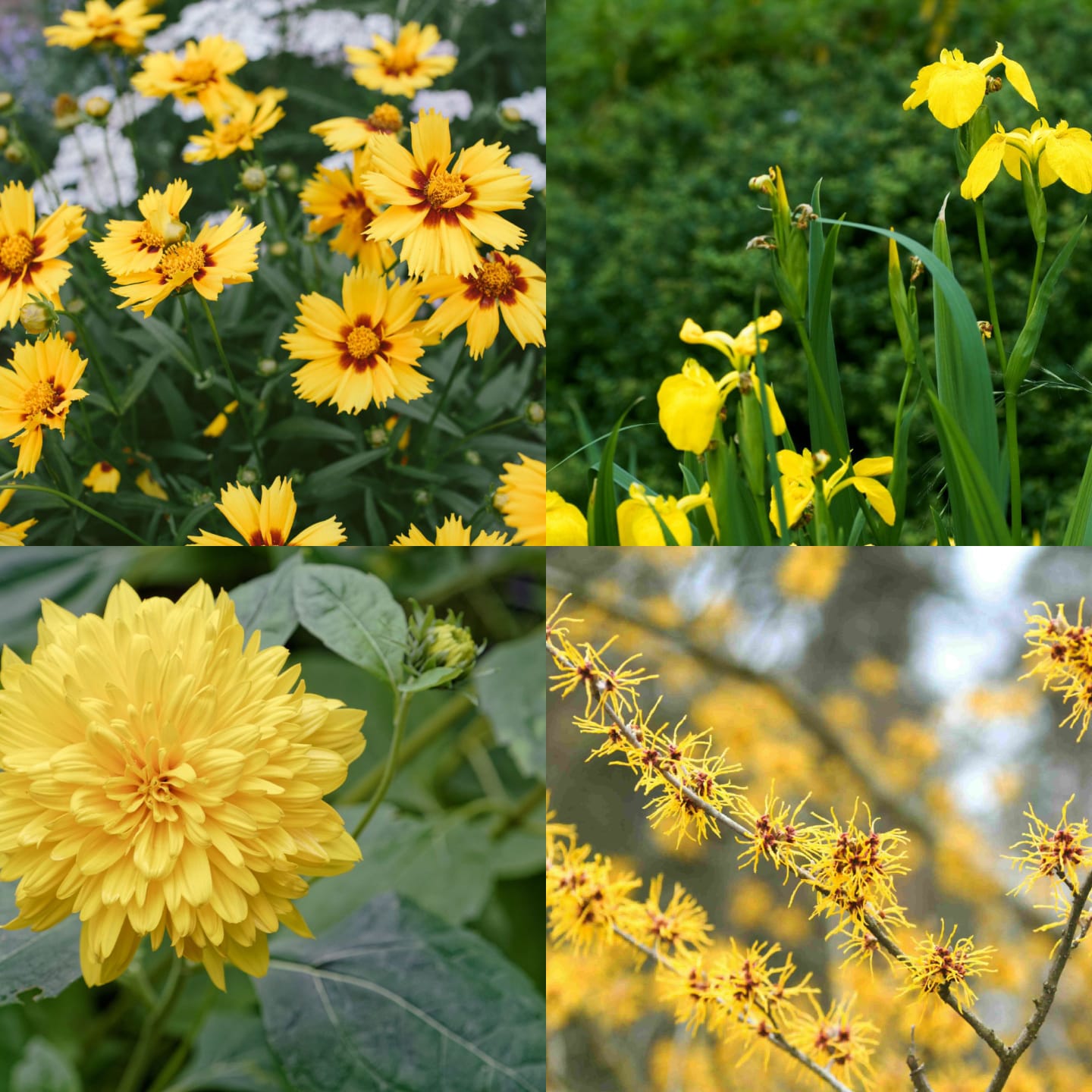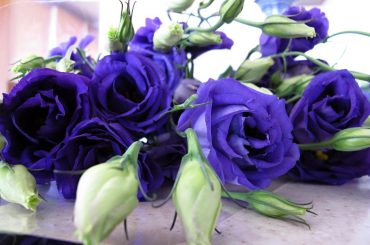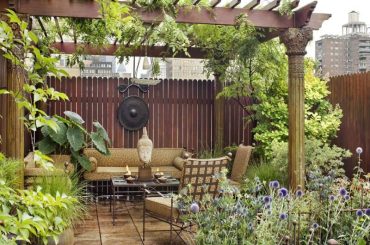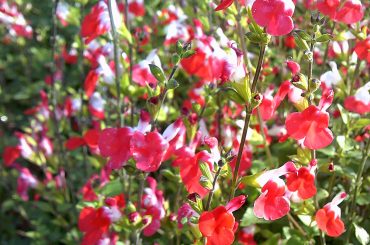Table of Contents
Welcome to the enchanting world of yellow flowering plants! Yellow colour is a radiant and attractive colour that gives a pleasant feel to the eyes. So, why not set up a garden full of yellow flowers? As a gardener, you can use your garden space up to your convenience. You can plant according to your liking and taste and try different colour combinations.
Yellow flowers possess a timeless charm that has captivated the human imagination for centuries. The colour yellow symbolizes joy, happiness, and positivity. Planting yellow flowers in the garden will keep your spirits up all day when you visit your garden.
Planting a flower, shrub, or any kind of plant in a garden needs some knowledge. Certain criteria should be considered while placing a plant in the garden. For instance, soil type, sun exposure, height and space between each plant, watering, bloom time, sensitivity to climate, and protection needed when necessary.
In this article, we will dive deep into each yellow flowering plant with its suitable criteria for the garden, and you can choose your plant for the garden.
Yellow Flowering Plants for Your Garden
1. Billy Buttons
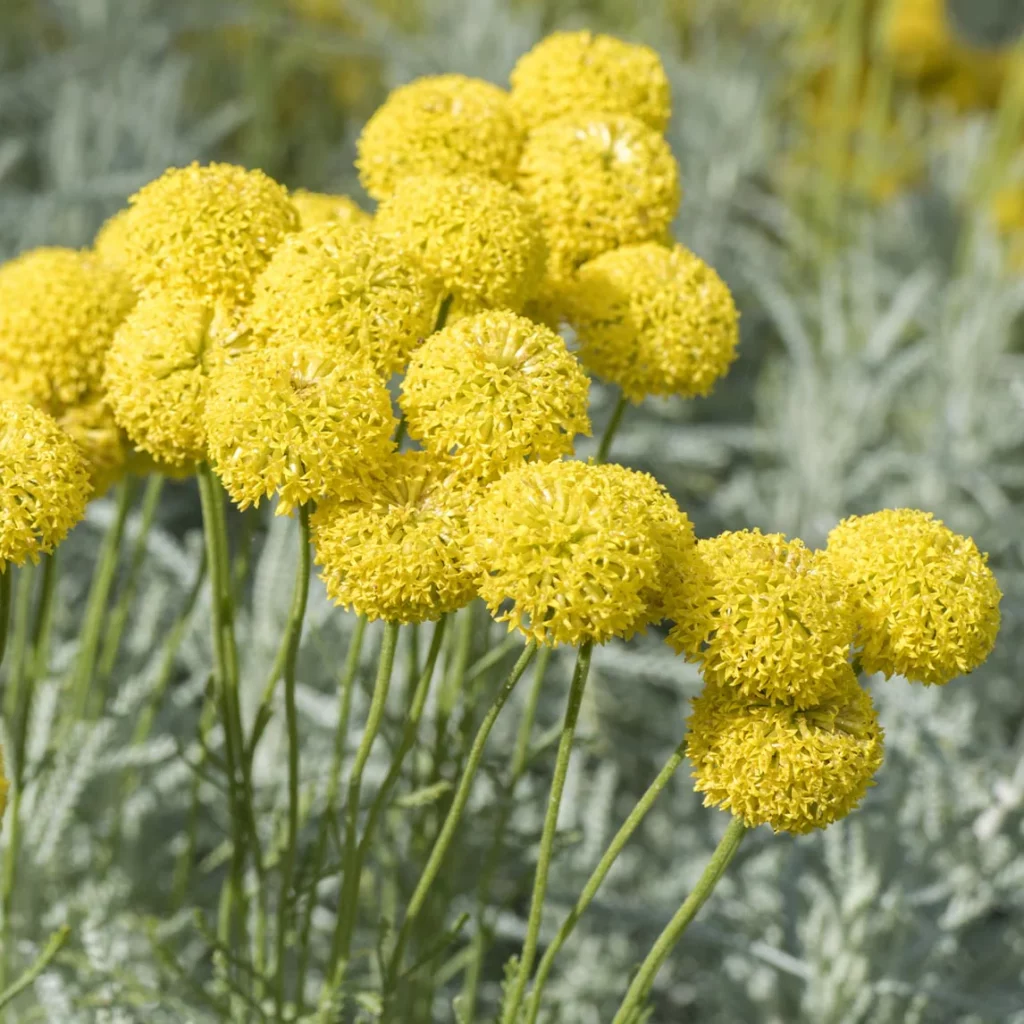
The billy buttons are perennial, herbaceous plants. They produce yellow flowers in a doom shape. The billy buttons are used in bouquets, table centrepieces, and garden flowers. The yellow flower grows up to 10 to 60 cm and has stout stems. The best time to plant them is during spring or summer; they bloom during spring and summer. Billy buttons are sun-loving plants and need full sun exposure to grow well.
The plant prefers any type of soil with acidic pH and well-drained soil. They are drought-tolerant plants and don’t require plenty of water. Feed them with a slow-release fertilizer. This will help during the growing season. They enjoy warmth and need a layer of mulch and use gravel for mulching. The flower is not delicate, but snails, slag, and spider infestation will kill the plan if left unnoticed.
2. Evening Primroses
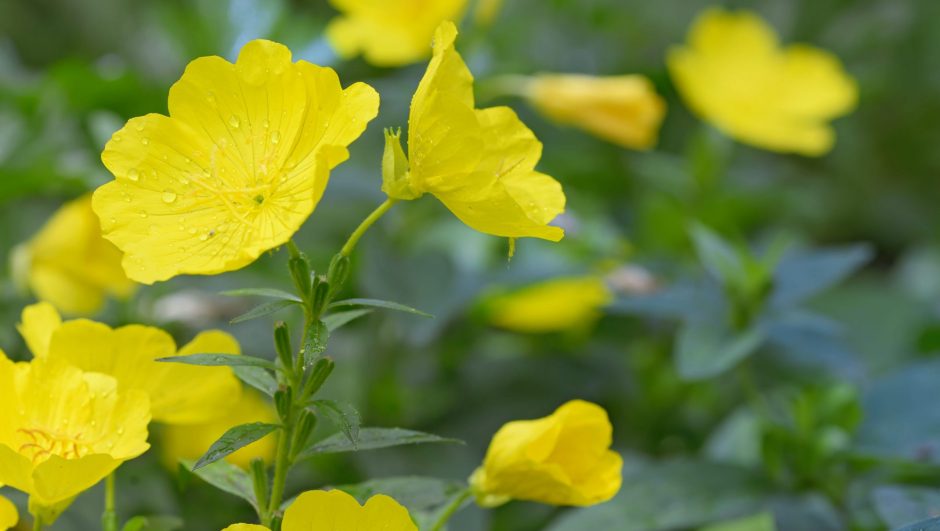
Evening Primroses produce lemon-scented yellow flowers. They are herbaceous and perennial plants. The flower grows up to a height of 3 to 5 feet and 2 to 3 feet in width. The plant needs full sun or partial sun to thrive well and preferably full sun. They prefer moist soil but well-drained soil but not water-logged; the soil with neutral to acidic pH and also can grow in rock and sandy soil.
Evening Primrose blooms during summer and fall. They need adequate watering during the growing season and a bit more watering during the hot temperatures. They do not need fertilizer because they are drought-tolerant and will grow fine without extra nutrients. The beetle will eat the leaves, but it will not kill the plants.
3. Austrian Briar
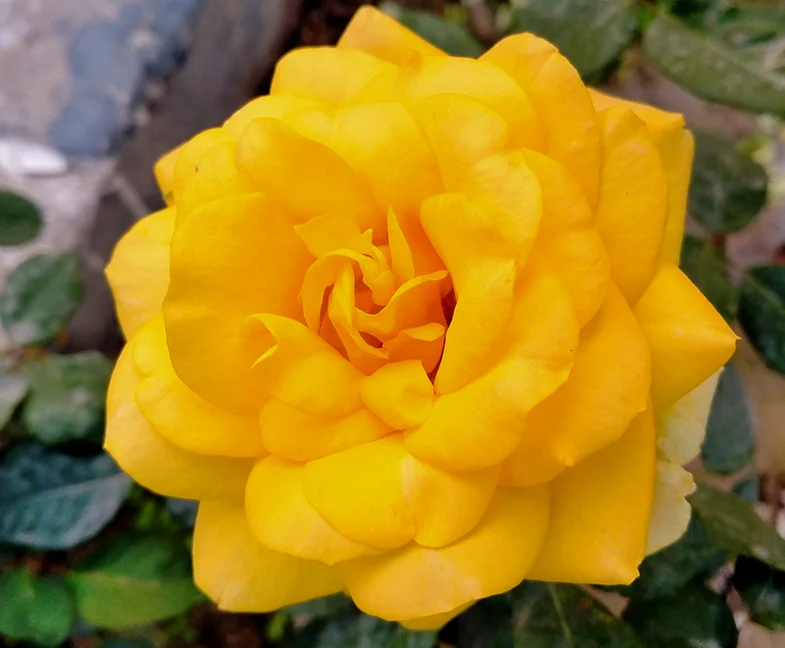
Austrian Briar produces rose-like, which is a bright and radiant yellow flower. The plant grows up to 5 to 10 feet tall and 48 to 60 inches in width. The Austrian briar blooms during early summer, and it is best to plant 2 weeks before this. They are a perfect match for accent, hedges and screening, mass planting, and general garden use.
The plant requires direct sunlight for 6 hours a day. Feed the plant with fertilizer for a few years for healthy bloom and avoid late growing seasons. The plant needs well-draining and moderately moist soil. While watering, keep in mind they need moist and well-drained soil and do not overwater as the soil may become soggy. These grow shrubs in your garden.
4. Chinese Flame Tree
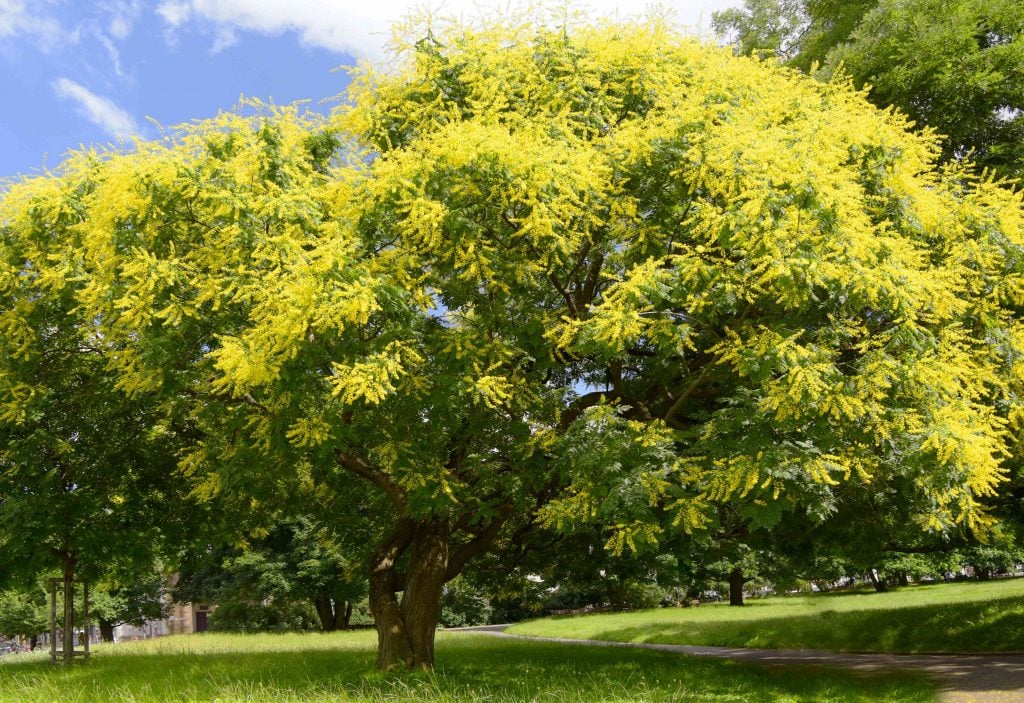
Chinese Flame trees will be an add-on to the garden for their huge yellow and bright appearance. They are best planted during the late spring and after the threat of frost. The tree grows up to 20 to 30 feet tall and 25 to 35 feet wide. The tree will bloom during the summer season. To grow to its matured size, the tree needs full sun exposure.
They thrive well in sandy, clay, and loamy soil with acidic and alkaline pH. Watering them regularly is a must but to a moderate degree. Drench the soil around the tree with water up to 6 to 9 inches. Feed the tree with slow-release fertilizer to encourage roots to grow healthy. The Chinese Flame Tree does not have a pest problem, but the old tree may develop root rot. The tree will overcome winter if sheltered properly.
5. Forsythia
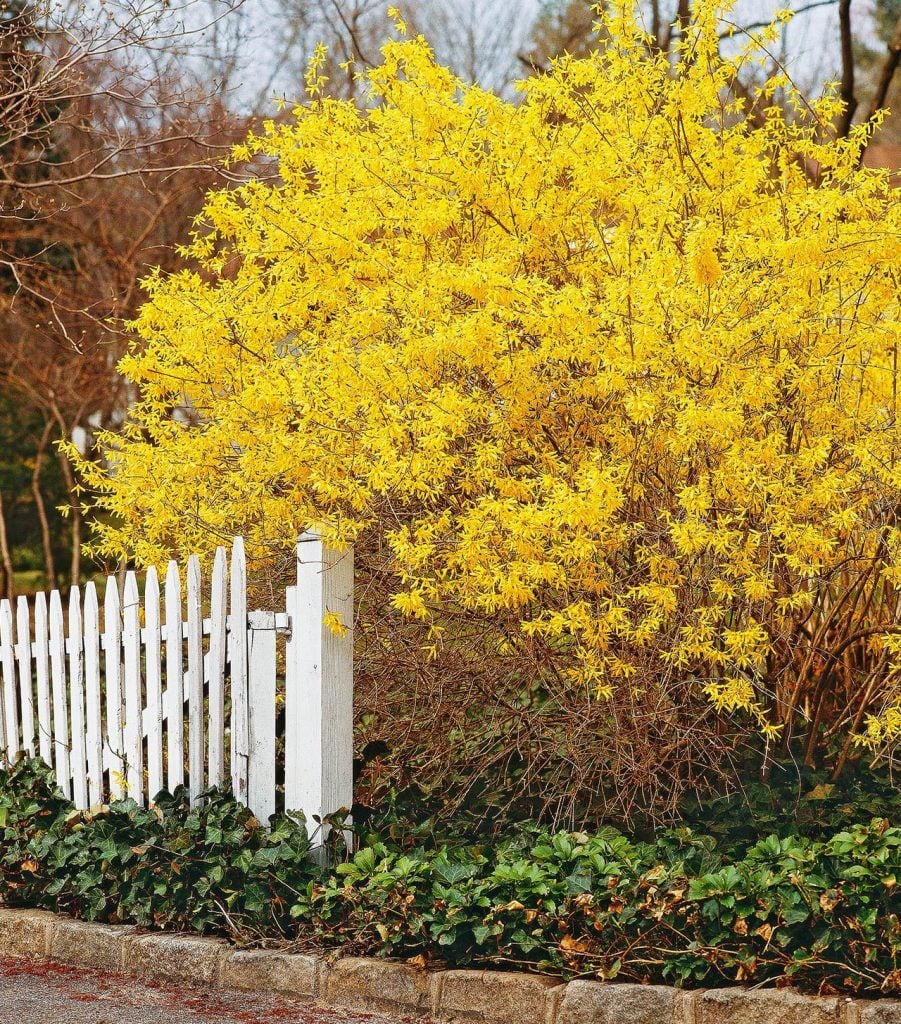
Forsythia is a shrub that produces foliage in yellow colour. The best time to plant them during autumn to late winter. The shrub will thrive well in full sun or partial shade. They are mostly trouble-free shrubs, and they do not have pest attacks, but common pests like aphids and nematodes may disturb the plant. The roots are important, and to keep them in good condition, mulch the soil with well-rotted organic matter.
Feeding the shrub with general slow-release fertilizer will boost its growth. They will thrive well in fertile and well-drained soil and can also grow in water-logged or extremely dry soil. The shrub grows up to 1 to 2 feet tall and 3 to 10 feet wide. They bloom during early-mid spring. The shrub is somewhat drought tolerant but will do best when regularly watered.
6. Day Lily
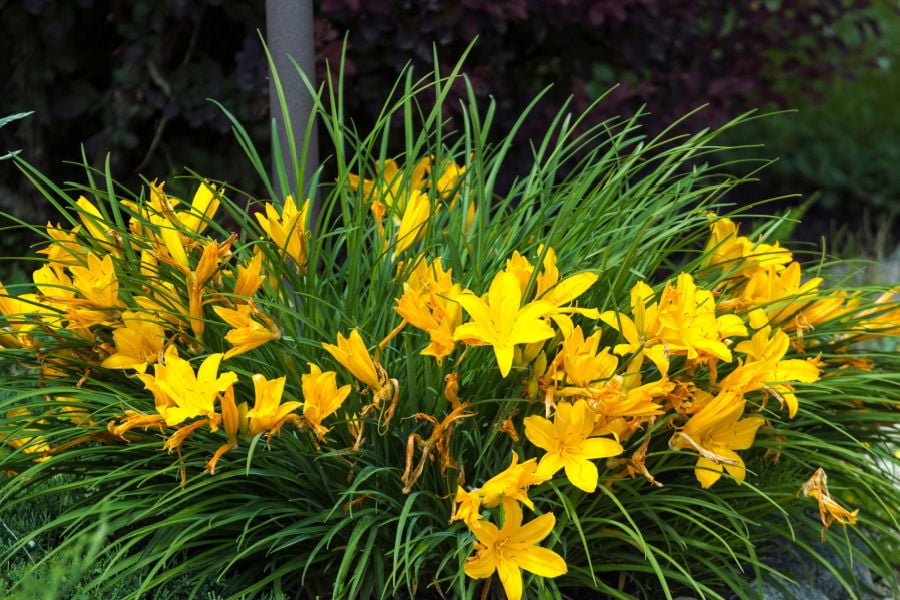
Day lily will produce yellow flowers with a stalk in the middle of the petals. They are a herbaceous, perennial plant that blooms during the summer month. The plant needs 6 to more hours of direct sunlight for growth. Feed the plant with slow-release fertilizer and low nitrogen. The plant will grow up to 1 to 3 feet tall in its matured stage.
The plant prefers moist, average to rich, and well-drained soil. They can also tolerate poor soil but no poor drainage. The plant needs to be watered consistently and especially during the spring season. Feed the plant with fertilizer once or twice during the growing season. The aphids or spider mites will be a pest problem for the plant. The flower is used for mass planting, in beds, meadows gardens, and as cut flower arrangements.
7. Yellow Iris
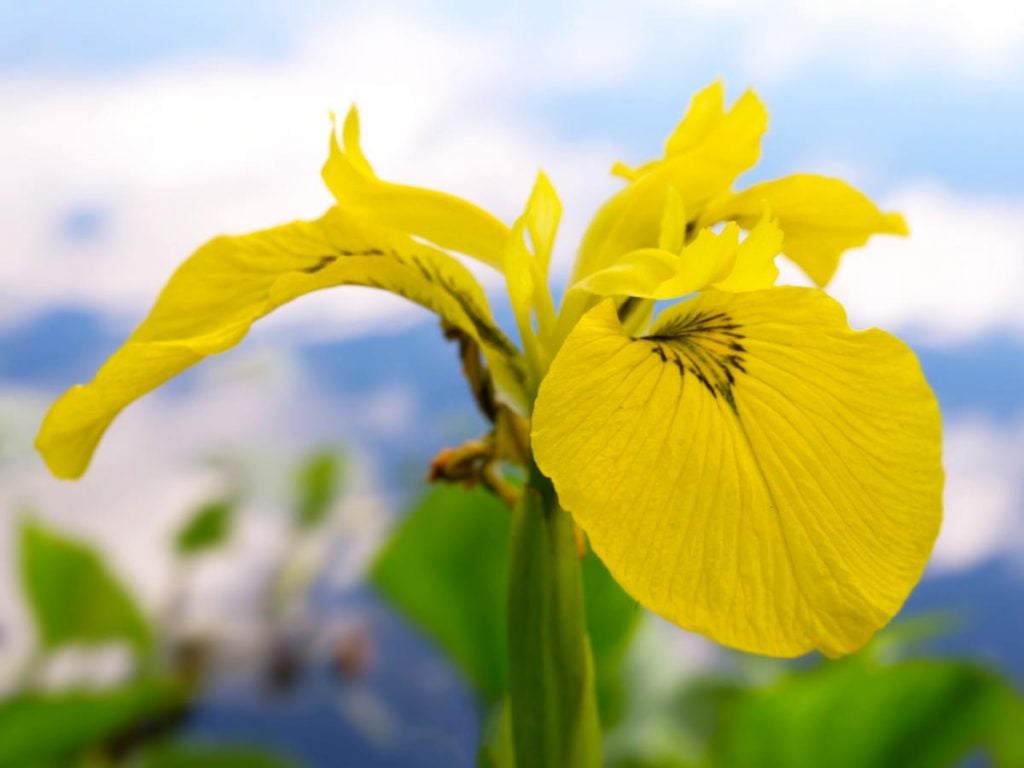
Yellow Iris produces a yellow flower with long thin petals. They are herbaceous, perennial plants that bloom during the late spring to early summer. The plant grows up to 3 to 5 feet in height and 10 cm in width. They will thrive well in full sun or partial shade. The plant prefers acidic soil with neutral pH and moist to wet soil, which is rich in humus.
The Yellow Iris is toxic to dogs, cats, and horses, so keep these animals away from the garden. They need additional nutrients for growth, so feed them with an average degree of fertilizer, and in spring, feed them manure tea. Water them regularly as they prefer wet soil, so keep them moist always. Grow them in containers to prevent the unwanted spread of rhizomes. They will also grow well in water 6 inches deep.
8. Goldenrod
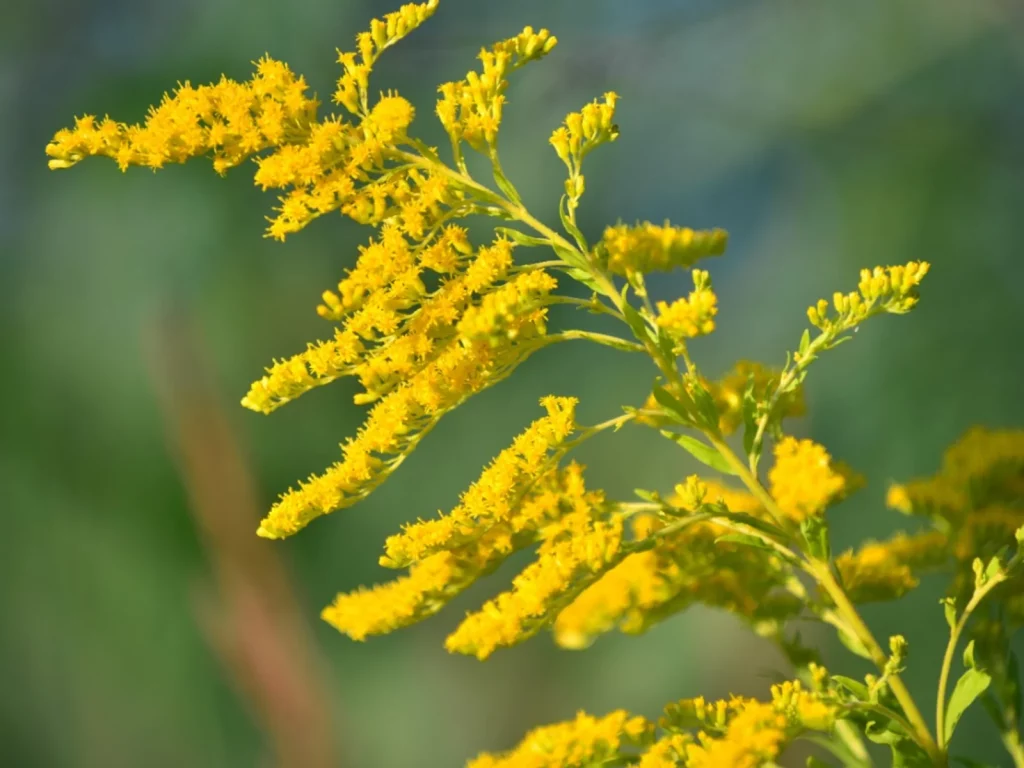
Goldenrod produces tall, slim, fluffy golden yellow flower spikes in a yellow shade. The plant grows up to 1.5 to 5 feet tall and 1 to 3 feet wide. The plant will thrive well if kept in full sun and will do well in partial shade too. The plant prefers average to infertile soil and well-drained soil. They bloom during summer and throughout the fall.
The plant needs well-drained soil and can also tolerate sandy, rocky, and clear soil. Water the newly planted weekly, but do not sog the soil. The plant is drought tolerant, so once growth is visible, you reduce the watering routines. The plant will grow well in lean soil, so there is no necessary to feed any fertilizers. Grow the Goldenrod in containers to avoid the spread of rhizomes.
9. Bush Cinquefoil
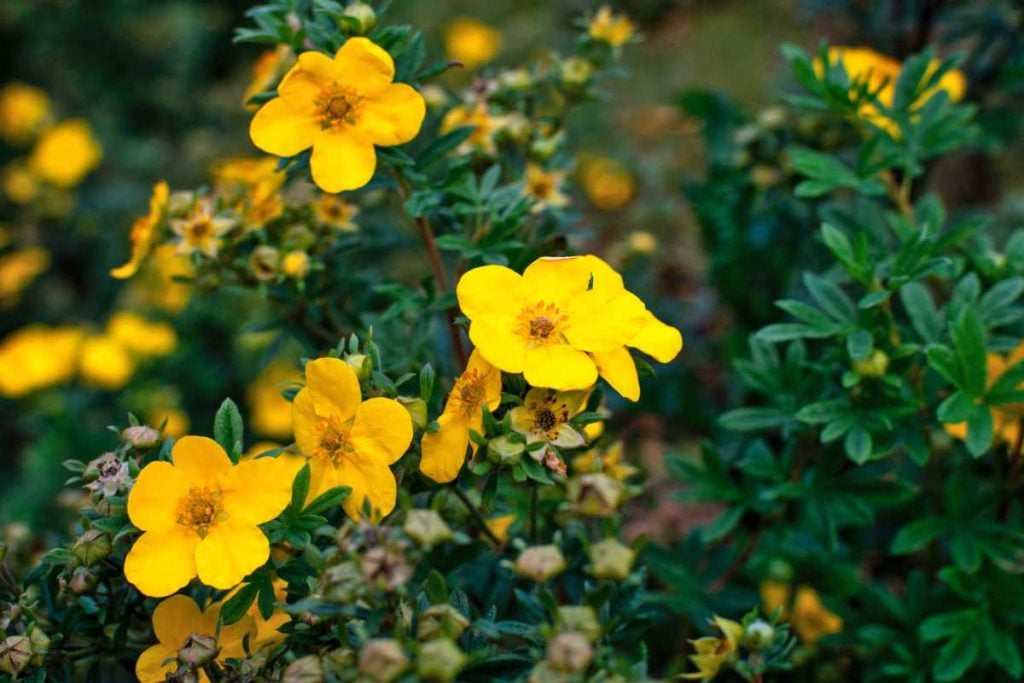
Bush Cinquefoil are shrubs that produce yellow flowers with small and nicely arranged petals. They generally bloom from June to September. The Bush Cinquefoil shrubs are low maintenance. They are mostly used as border plants, in beds, and as cottage gardens. They thrive up to 2 to 4 inches in height.
These shrubs will adapt to many soil types, even clay, and need well-drained soil for healthy growth. The plant should be kept in full sun or in partial shade to thrive well. You can see more plants on the full sun exposure side. Cinquefoils are drought-tolerant plants, so annual rainfall is sufficient for their growth. Use all-purpose fertilizers for flowering and use them in plenty during the early spring. Pests like aphids, lygus bugs, and spider mites will be a problem if grown in the garden.
10. Golden Barberry
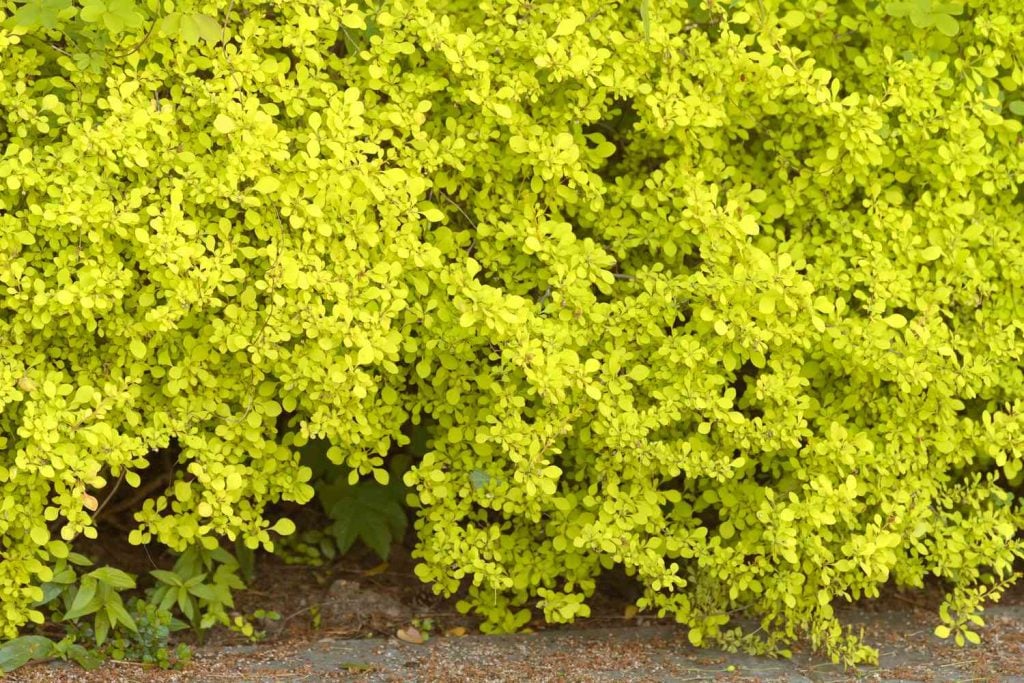
Golden Barberry is a shrub that gives yellow foliage and will give a complete background look for all other yellow flowers in the garden. They are deciduous shrubs that grow up to 3 to 4 feet tall and 3 to 5 feet wide. The shrubs will thrive well in full sun and also in partial shade. The plant prefers medium moisture, well-drained soil and requires acidic to slightly alkaline soil.
These shrubs mostly bloom from late April to early May. These shrubs are toxic to pets and humans, so keep them out of reach. They are drought tolerant, so it requires mild watering to survive. No need to feed them with fertilizer often, but you can add it during early spring. There is no notable pests problem, but aphids and webworms may affect.
11. Japanese Rose
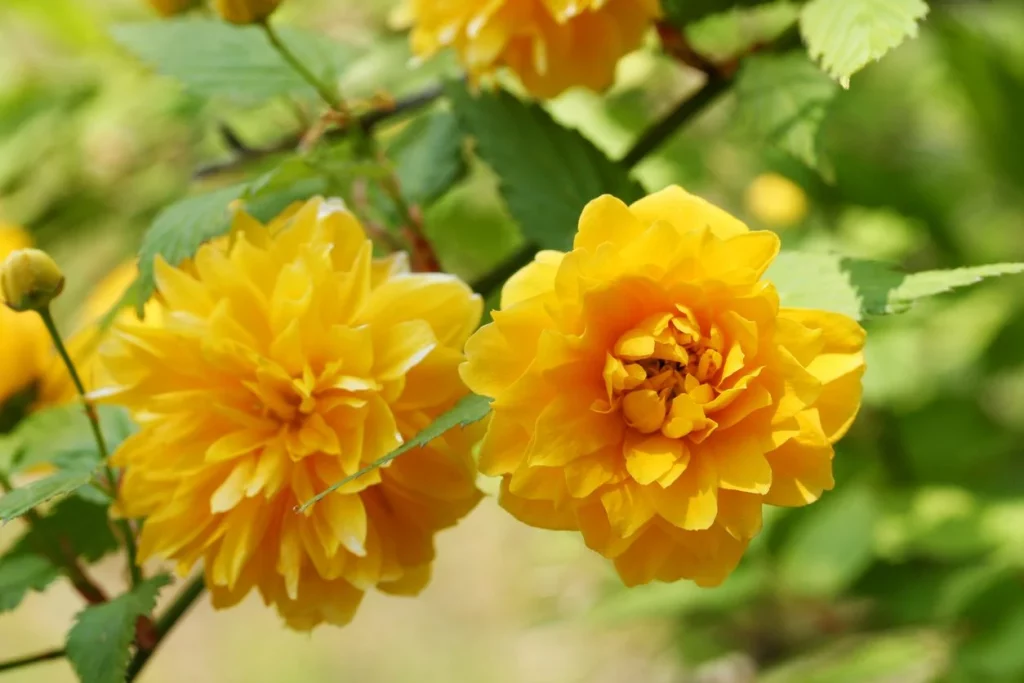
Japanese Rose is a deciduous shrub and has branch-like leaves with five-petaled yellow flowers. They grow up to 5 to 7 feet in height and 6 to 10 feet in width. They will thrive well in full shade and also in partial shade. If you need the best flower production, place them in full sun exposure. They prefer moist but well-drained soil and loamy soil with acidic, neutral, and alkaline pH. They usually bloom during the spring season.
The flower is shade tolerant too. Do not plant in heavy soil. Keep the soil moist but do not make it soggy. Mulch the soil to preserve the moisture of the soil. The plant needs regular watering but does not overwater them, and they are tolerant for short periods of droughts. Feed them with slow-release fertilizer and spread a layer of compost for added nutrition. However, they are tough specimens that can still be affected by the twig and leaf blight disease.
12. Honey Perfume Rose
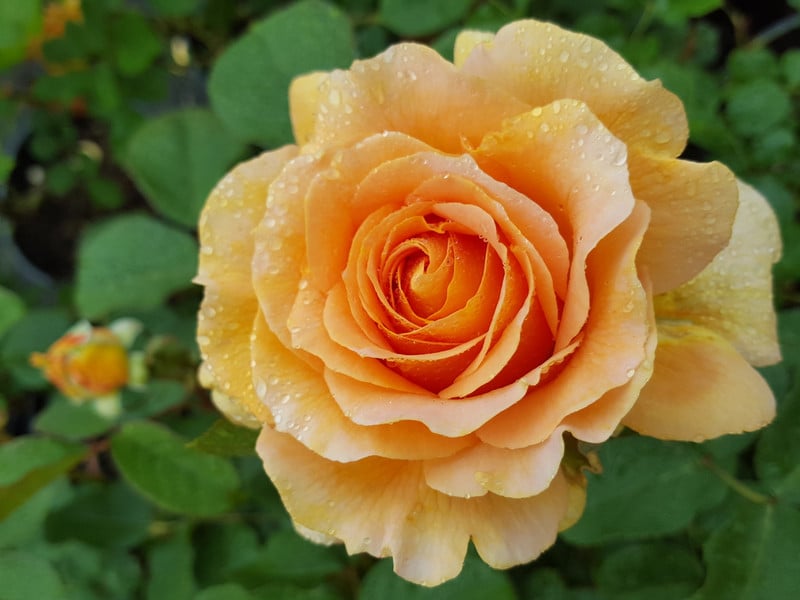
Honey perfume rose, as the name suggests, has bright colours and an inviting fragrance. They are deciduous, perennial rose shrubs that grow up to 3 to 4 feet in height and 2 to 3 feet wide. They need full sun exposure to thrive well. The plant prefers loamy, moist, well-drained soil with a slightly acidic ph.
They bloom during the late spring and early summer. Water the plant deeply and regularly but do not overwater them. Feed the plant with an all-purpose fertilizer in early spring, and it can also use throughout the growing season. Pest includes aphids, caterpillars, and spider mites, which need to be careful with.
13. Daffodil
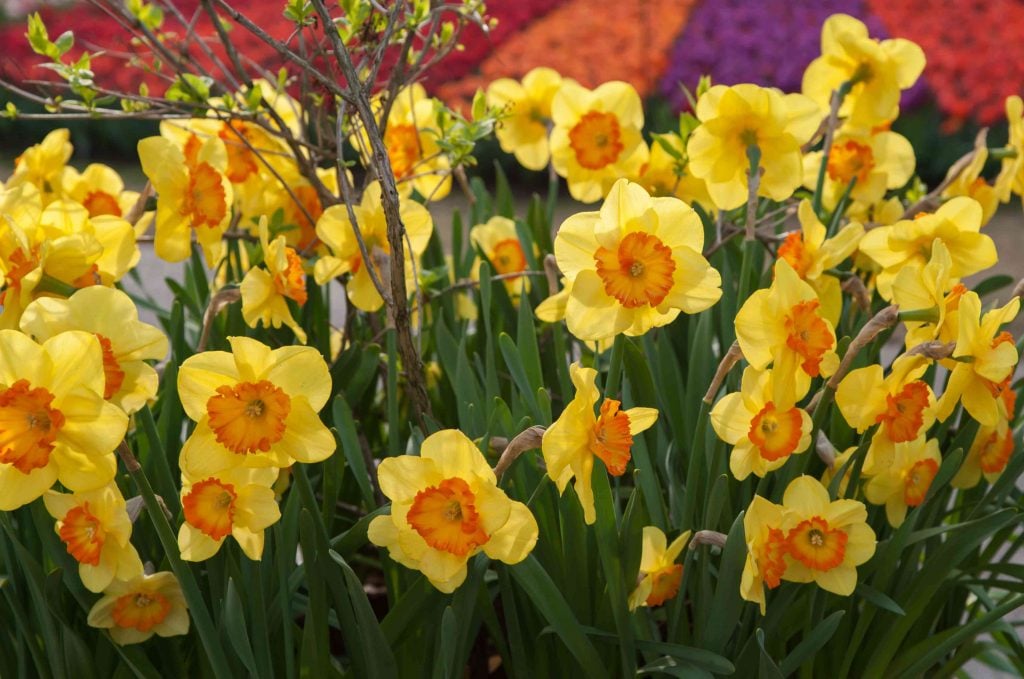
Daffodils are easy-growing, perennial bulbs that produce yellow flowers with five petal arrangements and orange colour in the centre. They grow up to 6 to 30 inches in height and 6 to 12 inches in width. They will thrive well in full sun and also in partial shade too. The plant prefers rich, moist, and well-drained soil with neutral and acidic ph.
The plant generally blooms during late winter and spring. The daffodil is toxic to pets and humans, so keep them out of reach. The best time to plant them is during late autumn, so flowers will emerge during spring. Water the plant regularly in spring and fall. The plant is pretty self-sufficient, so they do not need any fertilizer. The daffodils are immune to pests and disease, so it is a rare occurrence.
14. Golden Trumpet
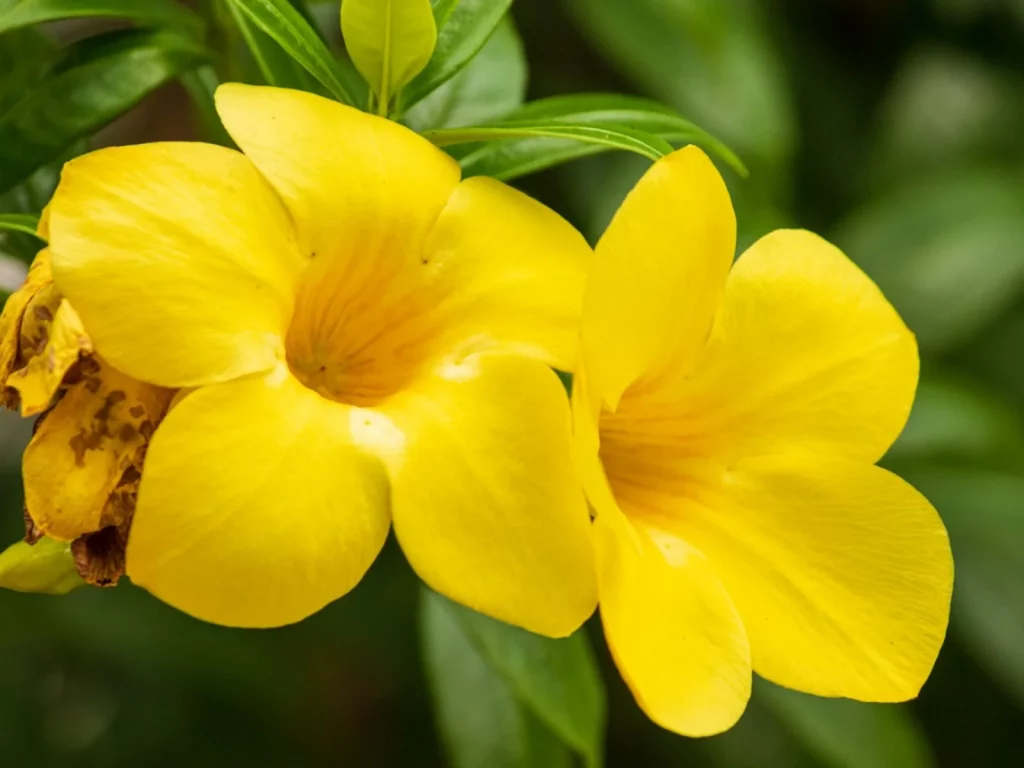
Golden Trumpet produces large, trumpet-shaped, deep golden yellow flowers which grow up to 4 to 6 inches in height and 2 to 4 inches wide. They are woody climbers and grow up to 15 feet tall. They will thrive well in full sun exposure. For best flower production, keep them in direct sunlight. They are used as landscape ornamental in tropical locations.
The plant prefers rich, well-drained soil and plenty of moisture. Water the plant regularly and deeply and allow the soil to dry slightly between the waterings. Fertilize the soil regularly during the growing seasons, especially when the plant is blooming heavily. Insect pests include mealy bugs, whiteflies, scales, and spider mites. The root will rot if they are overwatered.
15. Lydian Broom
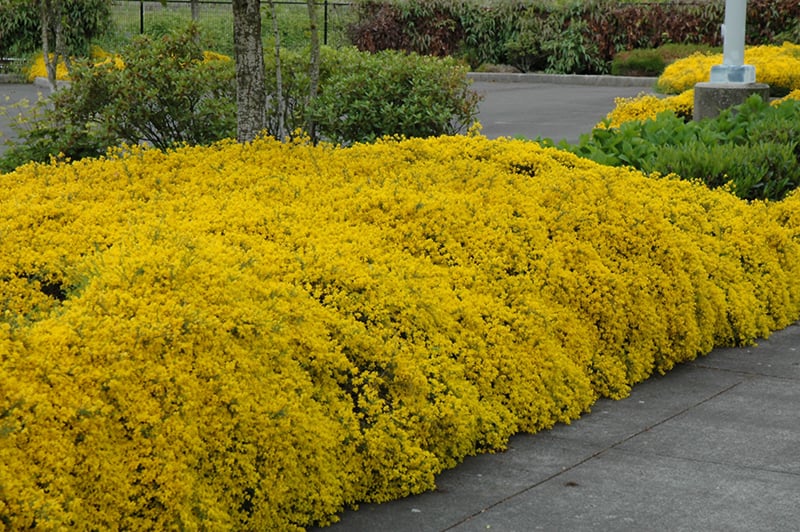
Lydian Broom is a low-growing perennial shrub that produces pea-like yellow flowers. They grow up to 1 to 6 inches in height and 2 to 3 feet wide. The plant needs 6 or more hours of direct sunlight and 2 to 6 hours of direct sunlight if kept in partial shade. The plant prefers loam and sand soil with alkaline, neutral ph.
The plant needs good soil drainage and occasionally dry soil. When planting them, space them between 12 inches to 3 feet. The Lydian Broom is a low-maintenance plant. There are no significant pest problems but always keep watch for aphids. They can be planted in small areas or drought-tolerant gardens.
16. Oregon Grape
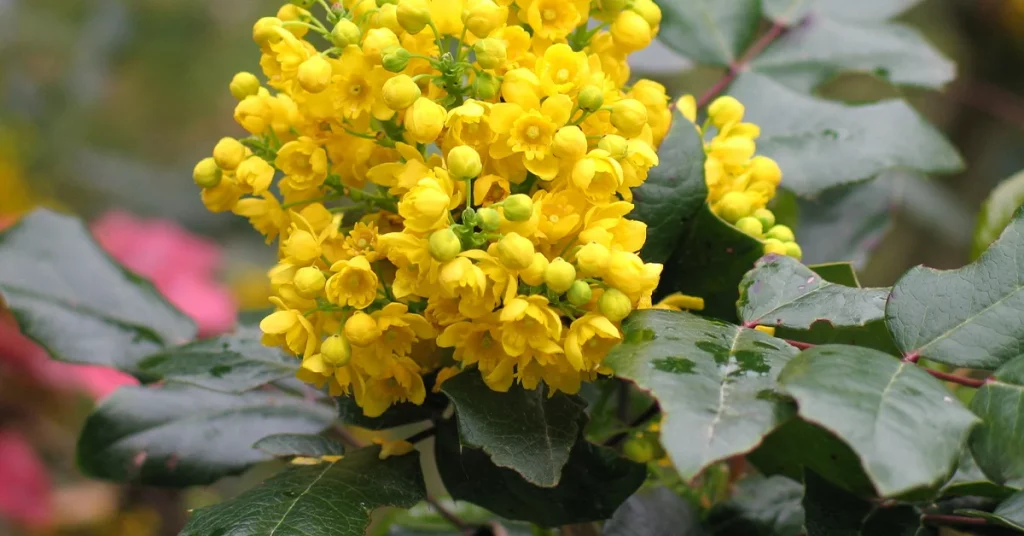
Oregon grape is an evergreen shrub that produces yellow flowers. They grow up to 3 to 20 feet in height and 2 to 5 feet in width. The plant will grow well in full sun and partial shade but will thrive best in partial shade. The plant prefers rich, well-draining soil with acidic to least neutral pH, as alkaline ph may be problematic. They bloom during April.
The yellow flower in the plant will turn into purple berries after the maturity stage. Water the plant weekly and keep the soil moist. Feed the plant with multi fertilizers like 10-10-10 fertilizer which will provide them with the right nutrients. While growing Oregon Grape from the seed, do not let the seed dry. There are signs of pests such as whiteflies, aphids, or scales.
17. Perforate St. John’s Wort
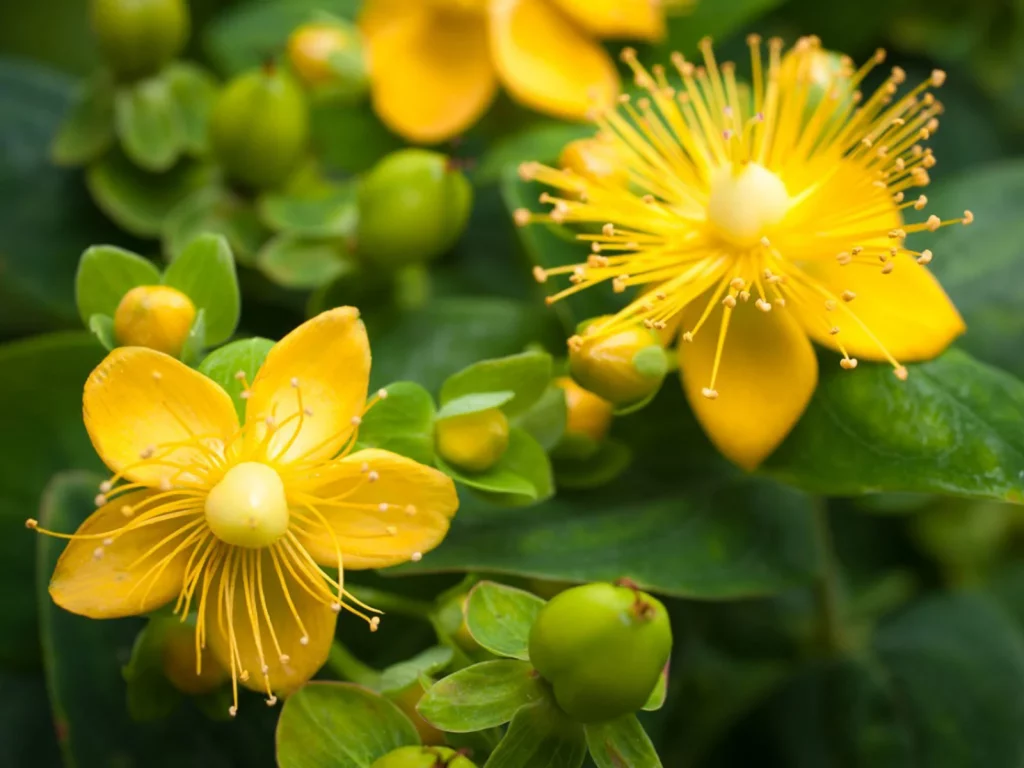
St. John’s wort is a herbaceous plant with perennial life cycle. They grow up to 1 to 3 feet tall, and it is not quite wide. They have uprooting habiting. The plant needs full sun exposure to partial shade to thrive well. The soil prefers rich, well-drained soil with average moisture content. The soil should be of acidic, neutral, and alkaline ph.
They bloom from June through September. Water the plant regularly when planted. Once they are matured, they become drought-tolerant. The plant will perform well in fertile soil, and it can tolerate poor soil. Combine the soil with compost for better growth. The St. John’s wort has beautiful ornamental features.
18. Leopard Plants
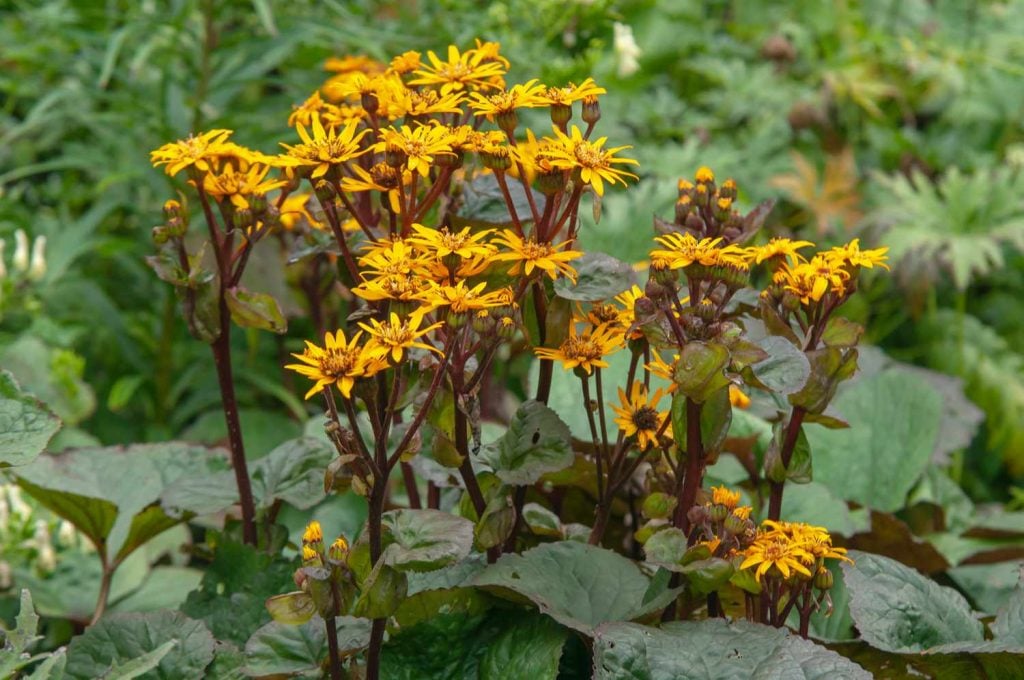
Leopard plants give yellow flowers and large leaves, and they are herbaceous, perennial plants. They grow up to 1 to 4 feet in height and 1 to 3 feet wide. The plant needs a part to full shade, and they cannot tolerate full sun as the flowers may wilt. The soil prefers rich, humus-heavy soil, which is moist and wet. The soil should be of slightly acidic ph level to slightly alkaline.
The plant needs adequate water. If frequent rain is absent, the plant needs irrigation. The plant bloom during the summertime. The plant is toxic to both humans and animals. If the plant is moist and wet with rich in humus, they do not require fertilizer. The plant is not prone to any serious pests or diseases but keeps checking for slugs and snails as these are drawn to leaves.
19. Prickly Pear
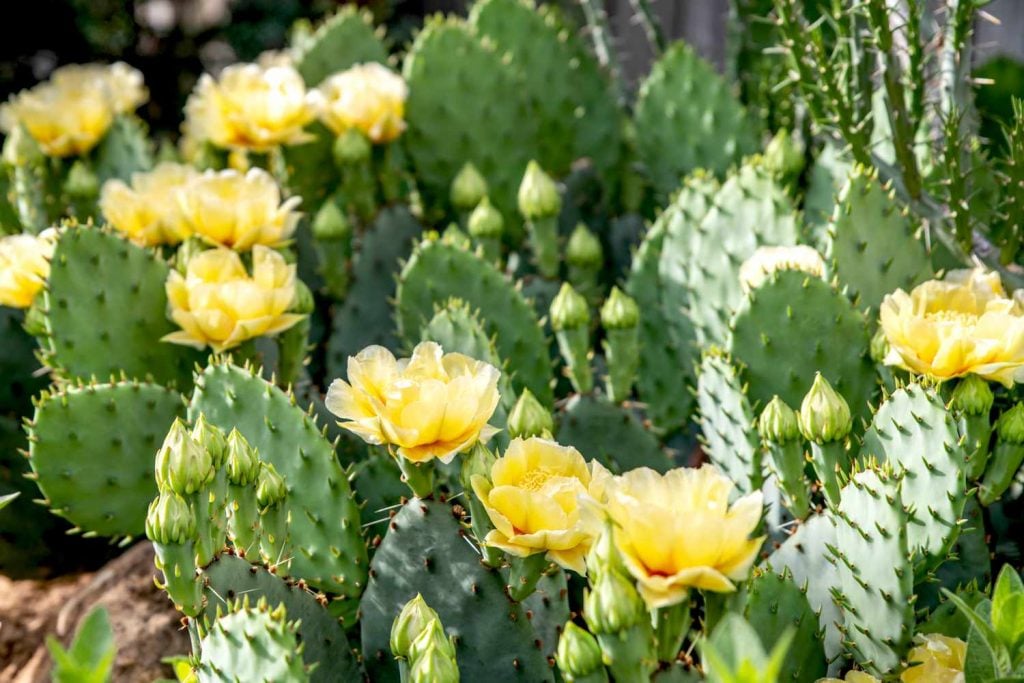
Prickly pear is a herbaceous, perennial cactus that gives yellow flowers. They grow up to 6 inches to 8 feet, and the width of the plant depends on the species. As you are planting all the yellow flowers, adding a touch with a cactus plant will be a classy one to your garden. They thrive well in full sun, and they love dry conditions.
The plant prefers dry, sandy or gravelly, well-draining soil. The soil should be acidic to neutral ph. The plant bloom from June to July. The plant has different care as compared to other plants. They need 6 hours of direct sunlight. If they are planted in a landscape, they will get lots of rain. The plant doesn’t need fertilizer if planted in the ground unless the soil is poor. Prone to a variety of insects and pests like scales and mealy bugs.
20. Canna Lily
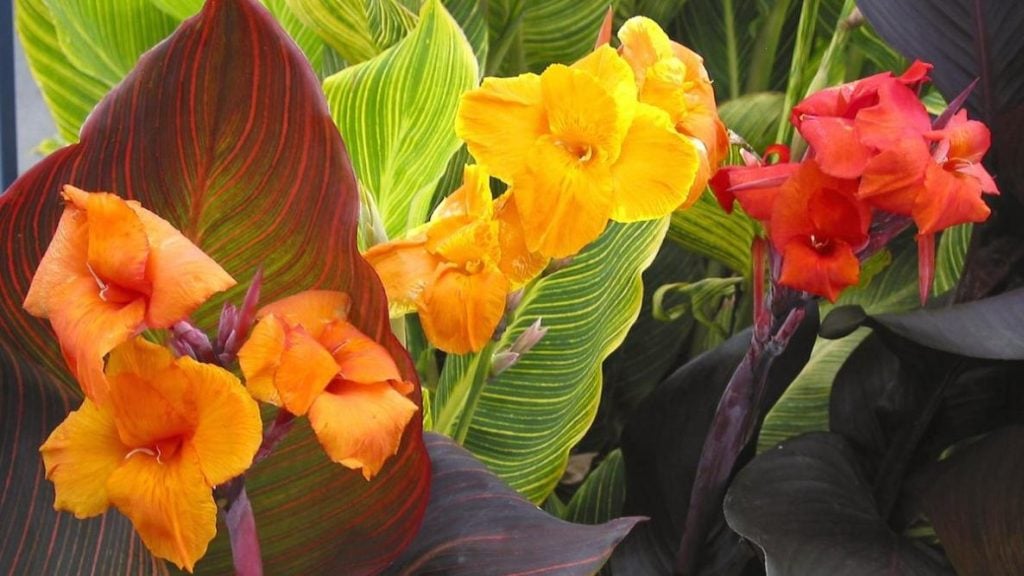
Canna lily is an annual, perennial rhizome that produces large, banana-like leaves in yellow colour. They grow up to 1.5 to 10 feet in height and 1.5 to 6 feet in width. They will thrive well in full sun. They need to be placed in full sun to rapid their growth. The soil prefers moist soil with acidic and neutral ph. The plant bloom during the summertime.
Water the plants regularly, especially during high temperatures. The canna lilies are hungry plants, and they store their food in the rhizomes. The rhizomes are the bulbs from which the Canna Lily is grown. These rhizomes will store the starch and act as roots during the plant’s growth. So you should feed them with a balanced fertilizer. They have a waxy cover that prevents water and protects from fungus.
21. Pontic azalea
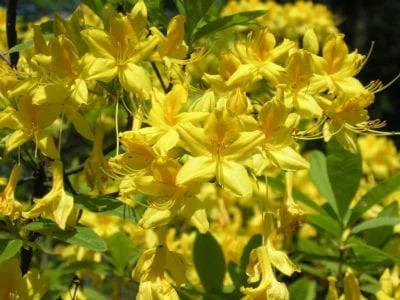
Pontic Azalea produces long, lanced-shaped leaves with strong, fragrant yellow flowers. They are deciduous shrubs that grow up to a height of 8 feet to 12 feet and a width of 0 feet to 0 feet. The plant needs full sun to grow well and for its best production. They are landscape shrubs and low maintenance. The plant blooms from mid-spring to late spring.
The plant needs partial shade to full sun for 6 or more hours. The plant prefers sandy loam to clay loam with acidic to neutral ph. Young plants need extra phosphorus for their growth and root development. Apply the fertilizer in the soil during the time of planting or the growing season. Water the plant when normal rainfall does not provide an average watering them during growing seasons. Pests like whiteflies, aphids, and caterpillars will be a threat to the plant.
22. Sweet Acacia
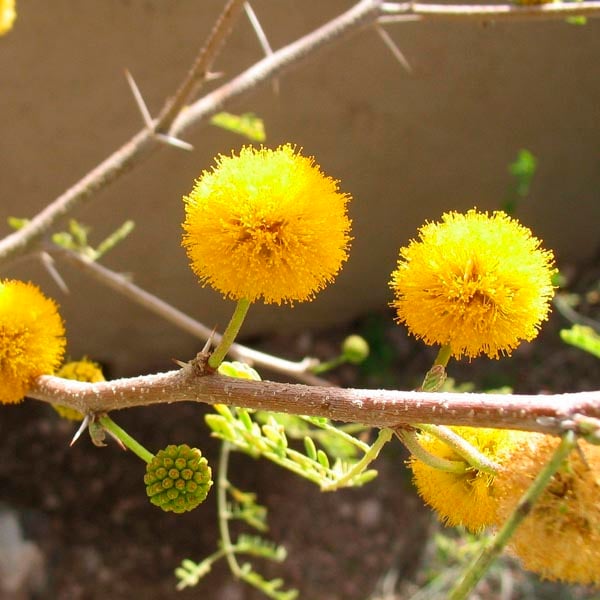
Sweet Acacia is not a normal landscape plant because of their sharp spines. Still, gardeners choose the plant for their fragrant and small puff yellow flower. They bloom during late winter or early spring. The tree also acts as a nesting site for the birds. They grow up to 15 to 25 feet in height. The tree needs full sun exposure to thrive well.
Water the plant occasionally after planting them; they are highly drought tolerant, so watering them once or twice a month will be sufficient. Protect the tree from frosting during the winter. The plant will grow in a variety of soil types if the soil has good drainage. They show a shrub-like growth habit. Sweet acacia does not have pest trouble, and they are not prone to it. Keep kids and visitors away from this tree because of their sharp spines.
23. Winter Jasmine
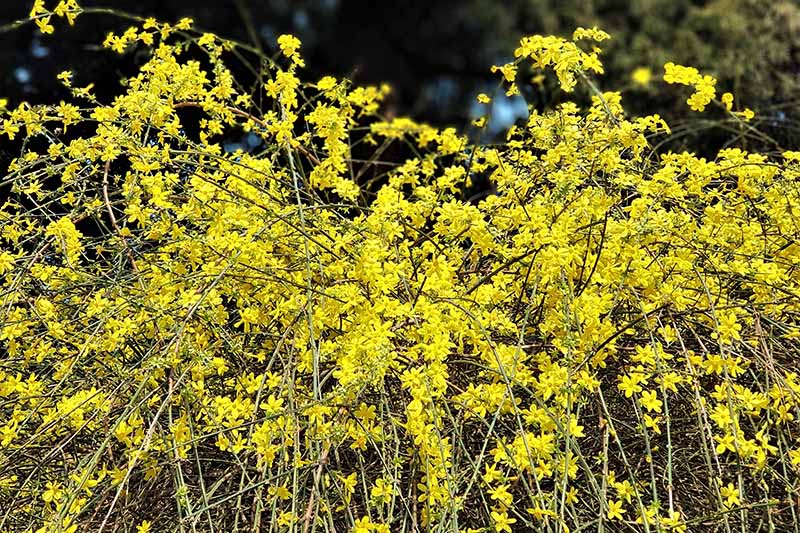
Winter Jasmine produces no fragrant, yellow flower with five petal arrangements. They are deciduous, perennial plants, and they are considered vines. They grow up to 4 feet to 15 feet in height, and they can climb up to 15 feet on a trellis. They will grow well when they are placed in full sun, and partial shade will do well if the plant gets a minimum of 4 hours of direct sunlight. The plant prefers chalk, loam, sand, and clay soil with acidic, neutral, and alkaline ph.
The plant blooms during late winter. Water the plant when you feel the top inch of the soil is dry. They do not require any fertilizer, but if you want good blooms, add slow-release fertilizer. They will do well in containers and planted in well-draining peat and sand soil moisture. Re-pot the plant in the spring after blooming.
24. Water Lilies
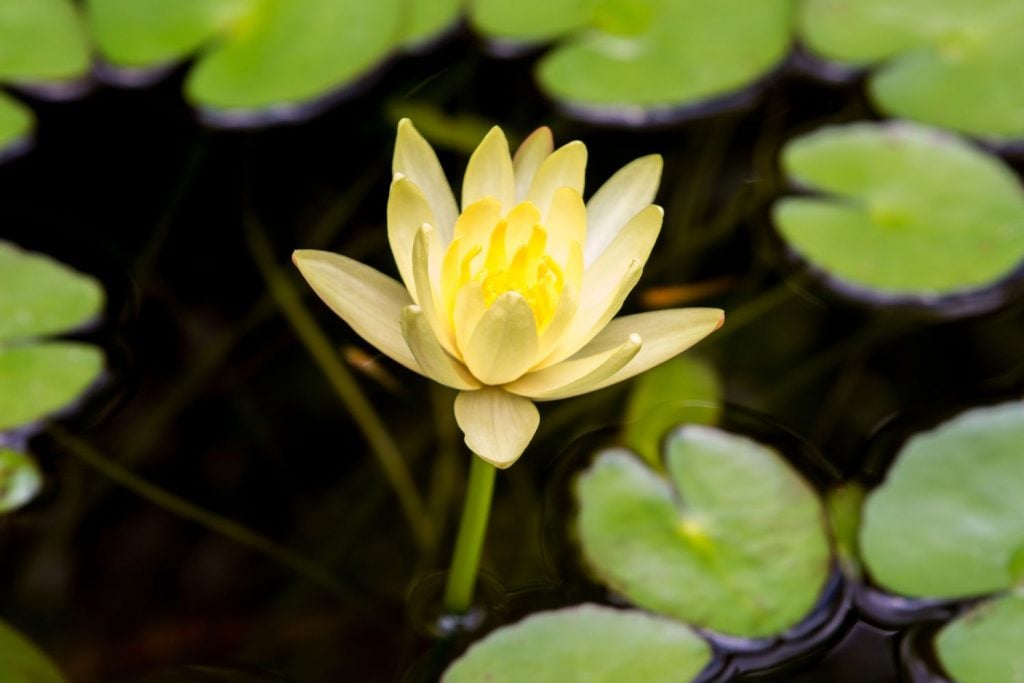
Water Lilies are aquatic plants. If you are planning on placing a pond in your garden, this plant will be a perfect choice. They are herbaceous, perennial plant that grows up to 3 to 6 inches in height and 4 to 8 feet in width. The plant needs full sun exposure for at least 4 hours and ideally for 6 hours. The plant prefers loamy. Clay, slit, sandy soil with neutral ph and use soil that is free of herbicides.
Do not use potting soil, which has elements that will float. They bloom during the summertime. While placing the plant in the pond, it should be balanced between plants and the pond’s surface area, and pay attention to the depths of the plant. Press the tablet into the soil, and do not add the fertilizer to the water. It will change the ph of the water. From aphids to leaf-eating pests and moths to worms will attack the stems and roots of the plant.
25. Yellow Camellia Shrub
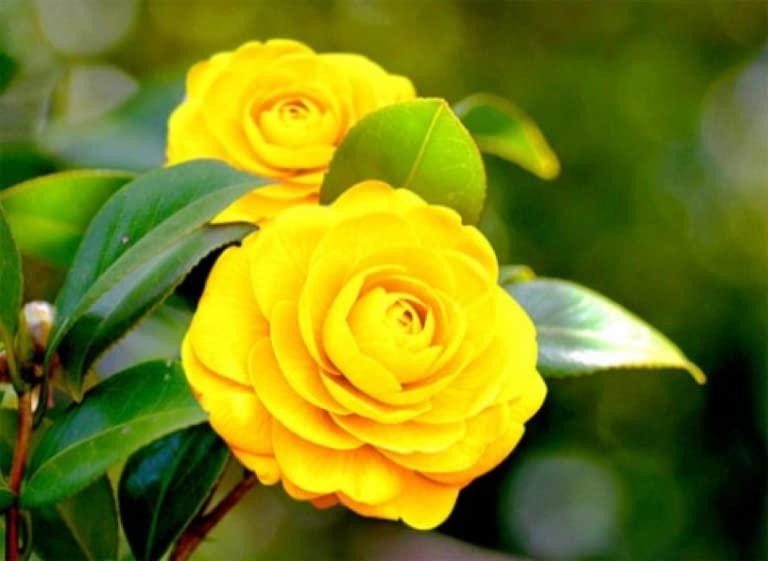
Camellia shrubs produce dark, large, glossy leaves and yellow flowers, and they are Evergreen shrubs. They will do well in partial shade, and long hours of direct sunlight may wilt the plant. The plant prefers rich, moist, well-drained soil with acidic ph. The plant will bloom during late fall, winter, and early spring.
The plant requires consistently moist soil for better growth. Feed the plant with nitrogen-rich slow-release fertilizer for added nutrients. Pests like aphids, thrips, mealy bugs, and scales are common pests that need to be kept a watch on. To treat these pest best treatment is neem oil. As plants bloom during mild winter, and if there is any chance of overwintering, protect the plant indoors but keep them in a cooler place.
Final Thoughts
Your exploration of 25 yellow flowering plants has revealed a world full of beauty and boundless wonder. Now you have gone through different plants that produce a yellow flower. By looking into the criteria needed to plant a flower, compare it with your garden conditions and choose the best suitable yellow flowering plant for your garden.
Throughout the journey, you have witnessed the yellow flower that uplifts our spirits and brings joy and positivity. Planting them in your garden will impact your daily mood and will keep you moving. These yellow flowers will change any kind of landscape into an enchantment or tranquillity.
From soil conditions to overwintering the plant, placing and spacing the plant between each other, to keeping them in the correct spot for sunlight, these criteria are to be considered while planting in the garden.
Thus, check your garden condition, compare, and choose the plant. You can also upgrade your garden conditions and plant the yellow flower to their preferences. Cherish and Celebrate the yellow flowers. Let them fill our lives with beautiful radiance and positivity.

